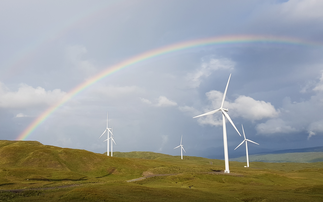Far from being a fantasy fuel of the future, hydrogen is already proving its green potential
Stable, flexible and clean, hydrogen has demonstrated that it belongs alongside renewables and natural gas as an environmentally friendly energy source of the future.
Atomically speaking, hydrogen is number one. It is the lightest of elements, and the most abundant in the universe. It has long been used to fuel modes of transport as polarized as rockets and hot air balloons. Now, through fuel cell technology, it is also increasingly used to power cars and buses.
But its potential as a fuel is far greater than transport alone, and attention is now turning to the use of hydrogen in power generation, working alongside renewables and natural gas.
Far from being a fantasy fuel of the future, practical solutions are already in place to move quickly and cost-effectively towards a hydrogen-powered world.
Fueling the future
While the ultimate goal is a world powered entirely by renewable energy, power generation in the near future will require stable fuel sources which are versatile and able to operate in a way that respects the environment.
Currently, fossil-fueled power plants are a leading source of global CO2 emissions.
One of the advantages of hydrogen is that it is flexible enough to be used in existing power plants, which can be converted to burn hydrogen. Adopting hydrogen as a fuel can therefore extend the operating life of coal or gas power plants, which may otherwise be decommissioned due to national or regional decarbonization policies or renewables' targets.
At Vattenfall's Magnum power plant in Groningen, the Netherlands, Mitsubishi Hitachi Power Systems is working to turn the owner's 'Carbon-free Gas Power' project into a reality. The objective is to convert one of the three gas turbines to combust only hydrogen by 2024.
The hydrogen needed will be produced by reforming Norwegian natural gas, and the resulting CO2 from that process will be captured and stored in natural caverns. This plant's transition to hydrogen could reduce annual CO2 emissions by 1.3 million tons each year.
Powerful potential
In addition, MHPS has also successfully tested the burning of a stable fuel mix of 30 per cent hydrogen with natural gas in a large-scale gas turbine, which reduced its CO2 emissions by 10 per cent. This was a major step towards achieving 100 per cent hydrogen combustion, but further enhancement is still needed.
Hydrogen can also be generated through electrolysis rather than by utilizing natural gas as a source. The electrolysis process requires only pure water and electricity. And as long as the electricity needed in the process is generated from renewable resources, producing hydrogen in this way would be carbon neutral.
Generating hydrogen by electrolysis could also offer an efficient alternative to batteries for storing surplus power from renewables. This solves one of the key challenges of renewable energy sources: since the power they produce is intermittent and cannot be turned on and off, it does not always meet demand.
Developing interest
Despite the technical advances, the sector's evolution depends to a large extent on national and regional policies.
While countries around the world adopt different approaches to hydrogen, progress is moving in the right direction. Several national governments have picked up the subject and published hydrogen strategies.
Mission Innovation, a global initiative of 23 countries, and the European Union launched its Renewable and Clean Hydrogen Innovation Challenge in May 2018 as part of its commitment to dramatically accelerate global clean energy innovation. This has prompted more cooperation from governments around the world.
The EU and some other countries such as Japan are also committing investment funds to developing hydrogen for both power generation and transport applications.
The US state of California is exploring the potential of utility-scale hydrogen production, followed by the UK, South Korea and Denmark. The Hydrogen Council expects one in every 12 cars in Germany, Japan, South Korea and California to be powered by hydrogen by 2030, alongside the deployment of hydrogen-powered trains and passenger ships.
Economies of scale
Currently, the sector is faced with a balancing act. On one hand investment is needed to develop hydrogen infrastructure and scale-up production, on the other hand the industry needs to achieve sufficient economies of scale to bring down the price of producing hydrogen from renewables.
Cooperation between industry representatives and policymakers will help create a framework for cross-market activation.
As the hydrogen market continues to grow, it is becoming an attractive proposition for people, companies and governments eager to improve their green credentials.
One day, this abundant element could play an abundant part of the energy equation.
To learn more about alternative energy trends and innovations, visit Spectra.
Spectra is powered by Mitsubishi Heavy Industries Group.
©Mitsubishi Heavy Industries, Ltd







